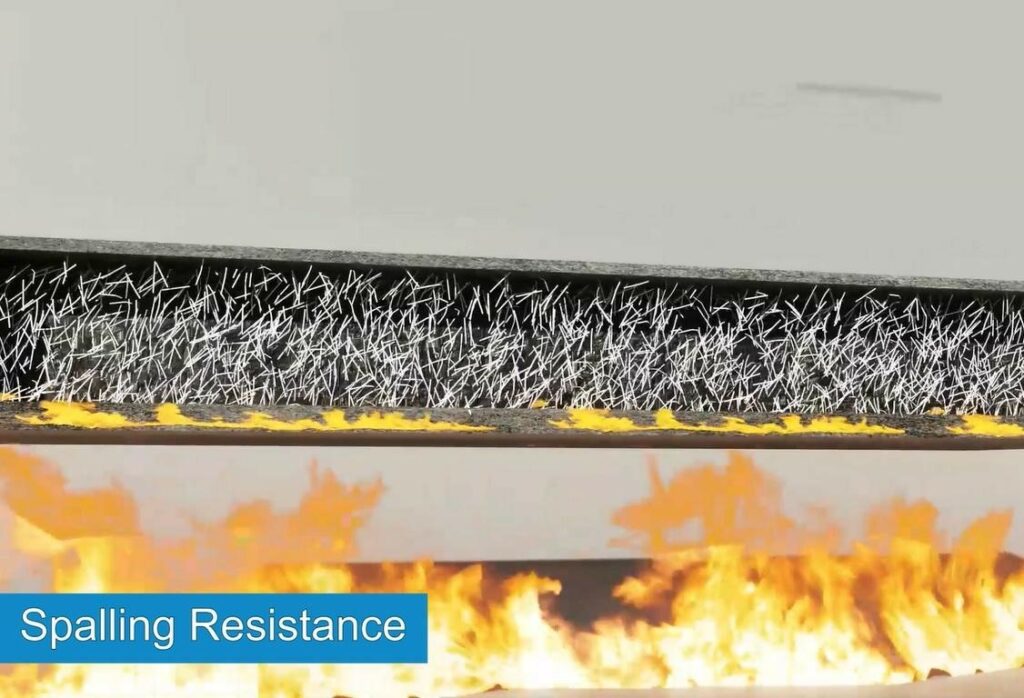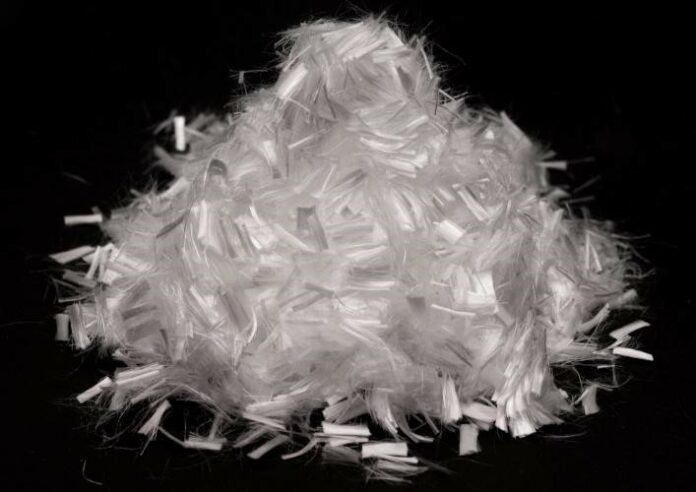Explosive spalling refers to a phenomenon that occurs in concrete structures due to rapid heating and release of moisture within the concrete. Concrete is a porous material that can contain water, either as free water or bound within the cement paste. When exposed to high temperatures, such as in a fire, the water trapped within the concrete can rapidly convert into steam. The rapid heating and vaporisation of water within the concrete generates high-pressure steam. As the steam tries to escape, it creates significant internal pressure within the concrete. If the pressure builds up to a critical point, it can cause the concrete to spall.
Causes of explosive spalling in concrete
Explosive spalling occurs in concrete due to a combination of factors,as discussed below;
- Moisture trapped within the concrete: Concrete is a porous material that can absorb and retain moisture. This moisture can be present as free water or bound within the cement paste. When exposed to high temperatures, the trapped moisture within the concrete can quickly turn into steam.
- Rapid heating and vaporisation: During a fire, the temperature of the concrete can rise rapidly. This rapid heating causes the trapped moisture to vaporize quickly, generating steam within the concrete matrix. The conversion of water to steam results in a significant increase in volume, creating high-pressure pockets within the concrete.
- High internal pressure: As the steam is generated within the concrete, it creates internal pressure due to the confined space of the concrete matrix. The pressure builds up as more steam is formed, exerting stress on the surrounding concrete material.
- Thermal stresses and cracking: The rapid temperature rise and the resulting pressure buildup lead to thermal stresses within the concrete. These stresses can cause the concrete to crack and spall, especially if the pressure becomes too high for the concrete to withstand.
To minimise the risk of explosive spalling, fibre reinforcement can be used to control moisture ingress, limit crack formation, and reduce the potential for steam buildup within the concrete during a fire. Fibers, such as polypropylene (PP) creates a three-dimensional reinforcement within the concrete matrix. This helps distribute stresses and limits crack formation and propagation. By controlling cracking, fibers can reduce the pathways for steam to escape, decreasing the potential for spalling. The addition of fibers in concrete can help absorb and dissipate the heat energy generated during a fire. This energy absorption reduces the temperature gradients and subsequent pressure buildup within the concrete. By reducing the internal pressure, fibers help mitigate the risk of spalling. The selection of the right polypropylene fiber product is the key. Kalyani Polymers Pvt Ltd. under the brand name FIBERCRETE® manufactures Synthetic Monofilament Fiber that helps induce explosive spalling in concrete.
FIBERCRETE® Synthetic Monofilament Fiber to induce explosive spalling

FIBERCRETE MF is a Synthetic Monofilament Fiber for concrete reinforcement that complies with Standard Specification for Fiber Reinforced Concrete and Shotcrete, and is specifically designed to help mitigate fire induced concrete spalling. FIBERCRETE MF’s have a length of 6 mm, cross- cross-sectional diameter of 15 to 20 microns, and specific gravity of 0.91. The product can prevent collapse in high strength concrete structures, such as tunnel lining’s explosive spalling by the melting of the fibers at high temperatures, leading to the dissipation of the internal vapor pressure. The fibers can also help to control the formation and propagation of cracks, thereby reducing the potential for spalling. They provide additional tensile strength and energy absorption capacity to the concrete, improving its resistance to cracking and fragmentation.
In case of any fire accidents, these microfibers act as capillaries or ducts. Fibers get liquefied and create pores in the concrete to ventilate the accumulated smoke/steam from the inner area to the outer atmosphere, which in turn reduces the internal pressure of the building and offers high resistance to spalling of concrete.
Advantages of FIBERCRETE MF to mitigate fire explosive spalling in concrete
FIBERCRETE synthetic monofilament fibers can be used as a type of reinforcement in concrete to help mitigate the risk of explosive spalling during a fire, its advantages include;
- Crack control: Synthetic monofilament fibers create a network of reinforcement throughout the concrete, which helps control crack formation and propagation. By distributing stresses and limiting crack development, these fibers help to maintain the integrity of the concrete, reducing the potential for spalling.
- Steam release: During a fire, synthetic monofilament fibers melt or soften at high temperatures. As they melt, they create channels or voids within the concrete matrix. These channels act as pathways for the release of steam generated by the heating of internal moisture within the concrete. By allowing the gradual release of steam, the pressure buildup is reduced, minimizing the risk of explosive spalling.
- Enhanced residual strength: The incorporation of synthetic monofilament fibers in concrete can help improve its residual strength after exposure to high temperatures. The fibers provide reinforcement and help maintain the integrity of the material, enabling it to retain a significant portion of its strength even in the post-fire condition.
- Reduced pore pressure: The presence of PP fibers can reduce the permeability of concrete, limiting the ingress of water and reducing the available moisture content within the material. This helps to lower the potential for explosive spalling during a fire.

When using synthetic monofilament fibers for mitigating explosive spalling, it is important to consider factors such as fiber diameter, dosage, fiber length and concrete mix design. The specific requirements and recommendations may vary depending on the project and applicable codes or standards.
About Kalyani Polymers
Kalyani Polymers Pvt Ltd. under the brand name FIBERCRETE® offers a World Class Synthetic Micro & Macro Concrete Fiber Products under “MAKE IN INDIA” and “ATMANIRBHAR” to cater the requirements of Construction Sector in India and around the World and carries a valid CE (European Conformity) mark.
Kalyani Polymers has developed an in-depth understanding of trends and requirements, and in accordance developed unique technologies and manufacturing to best meet customers requirements. Having Accredited with ISO 9001 from TUV since 2008, Quality, Service and Innovation have been their Pillars of Development. They have customized Concrete Fibers products for every client, and cater to their needs after a thorough investigation of the requirements and necessities. The company’s ability to continuously expand its product range and apply new techniques to present systems by installing new machines for efficient manufacturing is aided by the ample space to innovate and commercialize new products.
For more details visit- https://www.fibercrete.in

